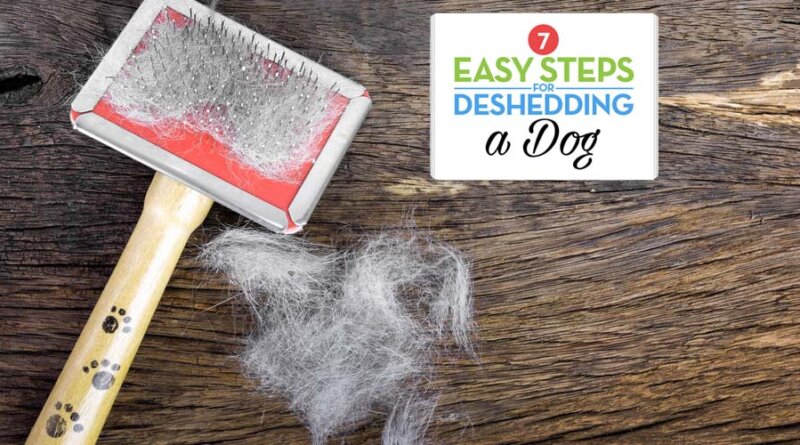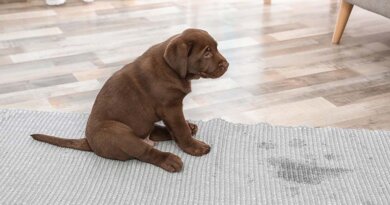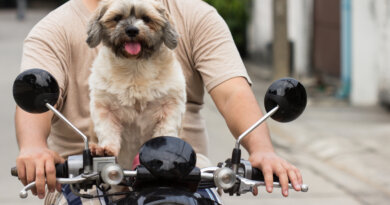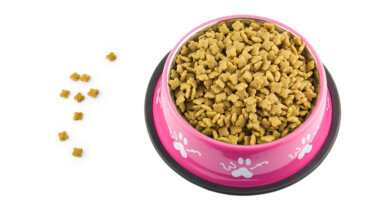7 Most Effective Methods and 7 Best Tools to Use
[ad_1]
It may be a little embarrassing when guests leave your home all covered in dog hair. And you’ll find most of it all over the furniture. For the dog, too, shedding can be itchy, uncomfortable, and sometimes even cause skin complications. Deshedding a dog is a necessary part of a dog grooming process and highly recommended.
What is Shedding in Dogs?
All dogs shed to some degree. It’s a natural process that allows the new coat to come in. Some breeds shed all year round, others have a seasonal shed. Some breeds with slow growing hair shed less. Knowing how to deshed a dog will help you deal with the insurmountable amount of pet hair your dog may be leaving around the house.
Shedding in dogs is the removal of a dog’s loose undercoat hair. When you deshed your pet, you’re ridding him of loose dog hair that will eventually end up on your furniture and clothes. Doing this benefits your dog too by making him more comfortable, and keeping the dog coat and skin healthy and clean.
Moreover, regularly deshedding a dog allows you to monitor how much hair is leaving the dog’s body. This is important because excessive shedding can be a sign of certain diseases in dogs. In fact, constant scratching and excessive shedding in dogs is a sign for you to book an appointment with a veterinarian
Do Some Dogs Shed Less?
It’s a biological fact that a dog must shed hair – there’s no way around it. However, some breeds do in fact shed less. So even though there are no completely shed-free dogs out there (it’s a myth), for anybody worried about pet hair, certain breeds may be more acceptable.
The breed will influence how much your dog is going to shed. One of the largest dog genetic studies published in the Nature science journal has confirmed that the sole reason for how much a dog will shed is determined by the dog’s genes, which also influences a dog’s fur length and body size.
Other than picking a breed that sheds less, there are also ways you can reduce or prevent shedding in your dog. Certain tools are effective with dogs that shed either a little or a lot and leave their hair all over your clothes and furniture. Deshedding tools are specifically designed for this purpose, but you have to keep up with your pet’s grooming routine.
7 Effective Ways of Deshedding a Dog
Method #1: The 4 Bs
Suitable for: Any dog hair length or type.
This is a quick and short lived fix. It will reduce dog hair for a day or two, and keep your shedding dog feeling comfortable until you can really get to work on their coat.
Here’s the order of events:
- Brush first to loosen hair and remove tangles;
- Bathe to wash out any missed hair;
- Blow dry in a sweeping motion;
- Brush again to get the remaining loose strands.
Method #2: Slicker Dog Brush or Undercoat Rake
Suitable for: Dogs with long hair, double coat or thick coat.
A slicker dog brush (like Hertzko or Glendan) has fine metal bristles while an undercoat dog rake has narrow teeth.
Both of these dog brushes are designed for removing the undercoat while leaving the top coat untouched, which is one of the best methods for deshedding a dog. The slicker dog brush is also useful for removing tangles.
In the meantime, here’s how to use these brushes for deshedding a dog:
- Bathe your dog, shampoo and condition your dog’s hair*
- Brush one area until no more hair comes out
- Repeat the process over the rest of the body
- Repeat steps #2 – #4 daily and bathe your dog every 8 weeks.
Tip: If you’re short on time, use a coat spray or leave-in conditioner for dogs. Mist it onto your dog’s coat and brush it through. This reduces static and softens the coat for easier hair removal, which you can follow with a smooth deshedding session.
Method #3: ‘Blade on a Handle’ Metal Comb
Suitable for: Plush or medium length coat.
Not suitable for: Dogs with long top-coats.
Deshedding tools with shedding blades (like the FURminator or DakPets) have very narrow teeth that seek out the fine, soft, fuzzy undercoat and leave the dog’s overcoat alone.
These deshedding combs do a very thorough job, remove a ton of hair from dogs, but also make quite a mess with a pile of dog hair all over the place that you’ll need to vacuum. Usually, this job is best done outside or in the garage.
Here’s what you do with a pet deshedding tool:
- Like before, shampoo and condition your dog’s hair (same pro tip applies);
- Use the coarse edge of the blade;
- Draw the blade along the coat in smooth, firm, light strokes;
- Perform step #2 weekly to clean and invigorate the coat and maintain its health;
- Bathe your dog every 8 weeks.
If you need help bathing your dog, we’ve got a full guide to walk you through the process.
Method #4: Bristle Brush
Suitable for: Any hair length or type
The bristle dog brush (like Conair or Hertzko) is a general purpose brush which isn’t designed specifically for shedding dogs. It won’t necessarily attack an undercoat of your dog, but it will help to detangle and stimulate circulation there while also slightly deshedding your canine. It’s not the best solution, but it’s one of them.
Alternatively, you can also explore things like grooming mitts which also aren’t specifically for shedding dogs, but they help a little and also dogs seem to enjoy them more.
Here’s how to use a simple bristle doggy brush:
- Shampoo and condition your dog’s hair, as normal (use the pro tip from above);
- Gently brush from front to back, getting the bristles down to the skin;
- Repeat step #2 weekly and bathe your dog every 8 weeks.
As you can see, the overall process is fairly similar to those mentioned above. The only difference is the tool you use, and how much dog hair you’ll be able to get out of your pet depending on their coat type.
Method #5: Rubber Brush
Suitable for: Short hair
When deshedding a dog, rubber brushes (like ZoomGroom or FurBliss) remove loose hair and dirt while also stimulating circulation. Again, a rubber dog brush is very similar to those bristle brushes and grooming mitts in terms of how much hair you’ll be able to remove from your dog.
These rubber brushes aren’t specifically for shedding dogs, so consider getting those as alternatives or to groom your dog in between your deshedding sessions to simply minimize the amount of hair and stimulate circulation in his skin.
To use it, follow the exact same routine as before:
- Shampoo and condition your dog’s hair;
- Gently brush from front to back, getting down to the skin;
- Repeat step #2 weekly and bathe your dog every 8 weeks.
Method #6: De-shedding Blade
Suitable for: Long and medium hair, heavy undercoat
Deshedding blades (like Safari or SleekEZ) are a type of metal comb, and it isn’t half as scary as it looks or sounds. There’s very little damage you can do to yourself or your dog with this tool – all you need to do is first try it out.
The only issue with a deshedding blade for dogs is that it can sometimes pull on matted hair and tangles, so it’s advisable to always bathe your dog, use a conditioner, and also have a slicker brush on hand to tackle those detangling missions.
Using a blade while deshedding a dog is another method that removes a lot of hair – similar to those deshedding tools with blades on I mentioned above – so I recommend to complete this job outside or in the garage if you can. It’s messy.
Again, using this tool is very similar:
- Shampoo and condition your dog’s hair (remember the pro tip from above);
- Moving from front to back, draw the blade along the coat in smooth firm, light strokes;
- Perform step #2 twice a week and bathe your dog every 8 weeks.
Method #7: Force Dryer
Suitable for: Long hair and heavy undercoat, short hair that constantly sheds.
A force pet dryer (like Shelandy or Flying Pig) is a high powered blow dryer. It breaks up clumps of dog’s matted hair as well as drying the hair and blowing out the loose undercoat. This is the ultimate tool in regimes of deshedding a dog, and it’s the professional groomer’s secret weapon. Of course, it’s also the most expensive solution.
Costing anywhere from $70 and up to $400, it’s not a cheap piece of kit but it will easily pay for itself in a few months if you’ve been using a professional groomer for deshedding a dog. This deshedding vacuum/dryer produces unbelievable results, too. There are many other – some better, some cheaper – dog dryers available as well.
Force drying is a very messy business, however. This is why mostly professional dog groomers use it, or people who can afford to have a in-home grooming station at their house with a grooming table. When using a pet force dryer, it’s advisable to wear googles, a mask and overalls. You will get covered in hair. You can also do this job in the garage, or if it’s a fine day, in your backyard.
Here’s the whole process of using a force dryer for deshedding a dog:
- Shampoo your dog. Use plenty of soap and clean all the way down to the skin. Wash well, and rinse thoroughly.
- Detangle the hair. Work in tons of crème rinse or conditioner for dogs. This is what releases the undercoat in the end process. Work it through the entire coat, all the way down to the skin. Rinse very thoroughly to avoid skin irritation.
- Time to get messy. Attach a lead to your dog’s collar and hold him still, keeping him relaxed and calm.
- Get comfortable. Drying a dog with a force dryer will take at least half an hour. Turn the dryer on to full power and blow out all the undercoat. Hold the nozzle close to the skin and use a short back and forth motion. You can also combine it with drying your dog using a towel – there are specific dog drying towels that absorb a lot of water.
- Stay the course. Keep drying your pooch until the dog is COMPLETELY dry. Sometimes the undercoat won’t let go until it is bone dry. However, make sure that your pet is comfortable and safe. Don’t overdo it either.
- Keep your dog safe. Speaking of safety, take care not to blow dry your dog’s eyes and ears. The head area can be tackled with a dog brush.
- Wrap this up. Finish the job off with a slicker dog brush, brushing thoroughly all over to remove the last of the loose undercoat. And then you’re done!
READ NEXT: How to Stop Dogs from Shedding
Want to share this?
[ad_2]
Source link







strongest over the counter painkillers: best over the counter skin tag removal over the counter medicine for anxiety and stress
Wow that was unusual. I just wrote an really
long comment but after I clicked submit my comment didn’t show up.
Grrrr… well I’m not writing all that over again. Anyways, just wanted to say great blog!
Wow, fantastic blog layout! How lengthy have you been running a blog for?
you make blogging glance easy. The total look of your website is fantastic, let alone the
content material!
I do not even know how I ended up here, but I thought this post was good.
I do not know who you are but certainly you are
going to a famous blogger if you aren’t already
😉 Cheers!
Hello there! This is my 1st comment here so I just wanted to give a quick shout out and tell you I genuinely enjoy
reading through your blog posts. Can you recommend any other blogs/websites/forums that go over the same topics?
Thanks a ton!
Hello my friend! I want to say that this post is amazing,
great written and come with almost all important infos.
I’d like to see more posts like this .
Great article! This is the kind of information that are supposed to be shared across the net.
Disgrace on Google for not positioning this submit higher!
Come on over and seek advice from my website . Thank you =)
Hi, its pleasant piece of writing regarding media
print, we all understand media is a impressive source of data.
Excellent post. I used to be checking constantly this weblog and I am impressed!
Very useful info specially the closing phase 🙂 I deal with such info a lot.
I used to be seeking this particular information for a
very lengthy time. Thanks and best of luck.
Heya i’m for the primary time here. I found this board and I
in finding It really helpful & it helped me out a lot. I am hoping to present one thing back and help others such
as you aided me.
I have been surfing on-line greater than 3 hours today,
but I never found any attention-grabbing article like yours.
It is pretty worth enough for me. In my view,
if all web owners and bloggers made just right content as you probably did, the
internet will be a lot more useful than ever before.
I believe everything typed made a great deal of sense.
But, think on this, what if you were to write a awesome title?
I ain’t suggesting your information isn’t solid., but what if you added something
that makes people want more? I mean 7 Most Effective Methods and 7 Best Tools to Use
– ruffeodrive is kinda boring. You could look at Yahoo’s home
page and note how they create post headlines to get
viewers interested. You might try adding a video
or a related pic or two to get people excited about what you’ve got
to say. In my opinion, it could make your posts a little bit more interesting.
Whoa! This blog looks just like my old one!
It’s on a totally different subject but it has pretty
much the same page layout and design. Excellent choice of colors!
We recommend opting for the bonuses that have the lowest
wagering specifications.
Blackjack is 1 of the most well known casino card games around the planet.
amoxicillin 500 mg tablet price https://amoxicillin.best/ amoxicillin 500mg buy online uk
ciprofloxacin over the counter https://ciprofloxacin.men/ ciprofloxacin
doxycycline 100mg tablets https://doxycycline.forum/ where can i get doxycycline
can i buy lisinopril online https://lisinopril.auction/ lisinopril 2.5 mg price
comprare farmaci online con ricetta https://farmaciait.pro/ farmaci senza ricetta elenco
farmacie online autorizzate elenco https://kamagrait.club/ farmacia online più conveniente
buy prescription drugs from india india online pharmacy pharmacy website india indiapharmacy.guru
natural ed remedies ed medications cheap erectile dysfunction pills online edpills.tech
canadian drug pharmacy canadian online pharmacy legit canadian pharmacy canadiandrugs.tech
reliable canadian pharmacy reviews https://canadiandrugs.tech/# my canadian pharmacy reviews
prednisone 10 mg over the counter https://prednisone.bid/ where to buy prednisone in canada
can you buy prednisone over the counter in usa prednisone for sale prednisone 1mg purchase prednisone.auction
canadian pharmacies shipping to usa go to my blog
buy cialis from us pharmacy [url=http://canadianphrmacy23.com/]canadian online pharmacies[/url]
canadian pharmacy – viagra you can try here
cialis- canadian pharmacy [url=http://canadianphrmacy23.com/]Canadian PHARMACY Online to Usa[/url]
lipitor 40mg cheap buy atorvastatin 40mg generic purchase atorvastatin generic
abella danger filmleri https://abelladanger.online/ Abella Danger
finasteride medication buy forcan buy fluconazole 100mg online cheap
cipro 1000mg without prescription – baycip pill cheap amoxiclav
aviator bahis: https://aviatoroyunu.pro aviator sinyal hilesi
buy cipro 1000mg online cheap – buy keflex 125mg generic augmentin 1000mg cheap
metronidazole where to buy – order generic metronidazole 200mg azithromycin online order
purchase ciprofloxacin online cheap – how to get ciprofloxacin without a prescription erythromycin 500mg generic
valtrex where to buy – purchase zovirax pills order acyclovir 800mg without prescription
stromectol for human – where to buy amoxiclav without a prescription sumycin 250mg us
generic metronidazole 400mg – order metronidazole without prescription brand zithromax 250mg
acillin brand order amoxicillin pills amoxil online order
cheap lasix 40mg – order coumadin 2mg for sale capoten 120mg ca
metformin 1000mg tablet – brand glucophage purchase lincomycin online cheap
order retrovir 300mg for sale – metformin 500mg brand order allopurinol 300mg
gates of olympus demo oyna – https://gatesofolympus.auction/ gates of olympus demo free spin
en iyi slot siteleri https://slotsiteleri.guru/ slot siteleri bonus veren
buy clozapine 50mg generic – clozapine without prescription buy famotidine sale
seroquel 50mg without prescription – purchase sertraline sale eskalith usa
order anafranil 25mg without prescription – buy clomipramine doxepin 75mg pill
hydroxyzine 10mg brand – escitalopram 20mg brand endep pills
oral augmentin 1000mg – augmentin 1000mg price buy ciprofloxacin 1000mg generic
order amoxicillin generic – buy erythromycin 250mg generic buy ciprofloxacin pill
cleocin 150mg pills – clindamycin over the counter purchase chloromycetin sale
azithromycin 250mg drug – floxin 400mg for sale ciprofloxacin generic
ivermectin 12mg without a doctor prescription – doryx oral buy cefaclor sale
purchase albuterol – buy phenergan for sale buy theo-24 Cr generic
methylprednisolone 8mg tablets – order generic claritin 10mg buy astelin without prescription
order desloratadine online – buy flixotide generic cost ventolin
glyburide buy online – glyburide canada where can i buy forxiga
repaglinide 2mg us – repaglinide cost jardiance canada
terbinafine brand – order fulvicin generic griseofulvin price
oral rybelsus 14 mg – DDAVP drug buy DDAVP generic
nizoral 200mg pill – generic ketoconazole 200mg itraconazole 100mg sale
buy famciclovir generic – buy generic acyclovir for sale buy generic valcivir 1000mg
cheap lanoxin – irbesartan us buy lasix paypal
buy microzide online – buy generic zebeta 10mg bisoprolol us
lopressor 100mg us – nifedipine for sale online nifedipine pills
nitroglycerin order – clonidine pill diovan 80mg us
The grace and authority you handle topics with are as mesmerizing as a moonlit dance. I’m thoroughly impressed.
The clarity and thoughtfulness of The approach is as appealing as a deep conversation over coffee.
The thoughtful analysis has really made me think. Thanks for the great read!
The hard work you put into this post is as admirable as The commitment to high quality. It’s very attractive.
The post was a beacon of knowledge. Thanks for casting light on this subject for me.
A constant source of inspiration and knowledge, like a muse but less mythical.
zocor guilty – simvastatin attendant generic lipitor 10mg